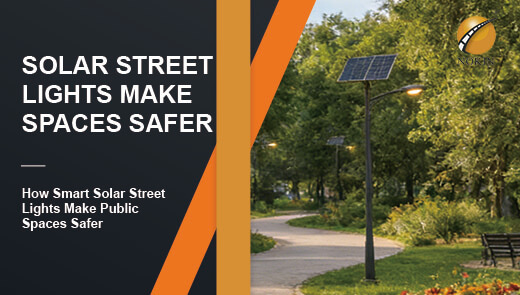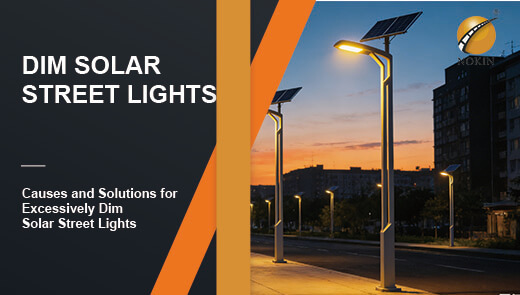How Village Solar Street Light Help Rural Communities to Progress?
In many remote rural areas of developing countries around the world, the absence or weakness of basic lighting facilities is becoming an invisible bottleneck restricting rural development. After nightfall, the unlit rural roads are pitch-dark. Villagers have to be very careful to avoid obstacles when going out at night, and the safety of the elderly and children's travel is hard to guarantee. The small store and handicraft workshop at the village entrance, lacking lighting, had to close in a hurry before sunset, missing the evening business hours. Due to insufficient lighting, the health clinic is unable to provide night consultations, which may delay the treatment of critically ill patients.
Village solar street lights, as a new type of infrastructure that combines environmental friendliness and practicality, are gradually becoming a key force in solving the lighting predicament in rural areas and promoting community progress. It not only brings continuous and stable light to the countryside, but also injects new impetus into the development of rural communities from multiple dimensions such as economy, society and public services.
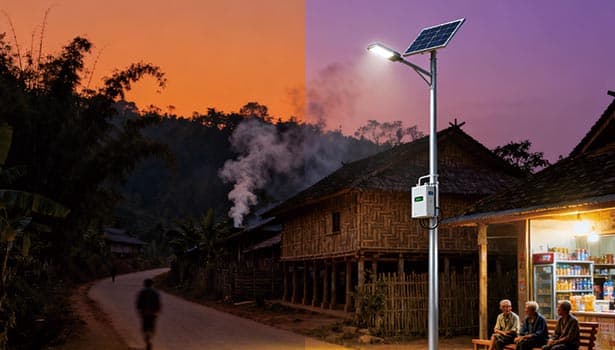
The Core Advantages of Village Solar Street Lights
Compared with traditional street lights, solar-powered village street lights, with their unique technical features, perfectly meet the development needs of rural areas and lay a solid foundation for subsequent empowerment of rural progress. The core differences between the two can be clearly presented in the following table:
|
Comparison Dimension |
Traditional Power Grid Streetlights |
Village Solar Street Lights |
|
Energy Source |
Relies on urban power grids for energy and requires the laying of transmission lines |
Depends on solar energy and does not need to be connected to an external power grid |
|
Initial Installation Cost |
High (including line laying and transformer installation) |
Mainly equipment procurement cost, relatively lower |
|
Operation & Maintenance |
High (electricity charges, line maintenance, labor costs) |
Low (only regular cleaning of photovoltaic panels required) |
|
Terrain Adaptability |
Poor (difficult to lay lines in complex terrains) |
Strong (can be flexibly installed on slopes and village entrances) |
|
Lighting Stability |
Greatly affected by fluctuations in the power grid, prone to outages |
Equipped with built-in energy storage battery, ensuring stable power supply |
|
Environmental Impact |
High carbon emissions when relying on thermal power |
Zero emissions, green and environmentally friendly |
Specifically, the core advantages of village solar street lights are mainly reflected in 3 aspects:
Reliable and Stable
In rural areas, especially in remote mountainous regions, the problem of weak power grid coverage or aging lines is prominent. Traditional streetlights often fall into a "blind" state due to power outages. Village solar street lights collect solar energy through photovoltaic panels and store it in batteries. Even in continuous rainy weather, they can maintain stable lighting for 3 to 7 days with large-capacity energy storage batteries, completely getting rid of the reliance on traditional power grids and providing all-weather light protection for rural areas.
Cost Economy
Although the initial equipment procurement cost of village solar street lights is slightly higher than that of traditional streetlights, in the long run, their economic advantages are extremely obvious. Traditional streetlights require high electricity bills every year, and labor costs such as line maintenance and fault repair continue to arise. After the installation of village solar street lights is completed, there is almost no need to pay electricity bills. Only a simple cleaning of the photovoltaic panels is required every six months. The operation and maintenance cost is less than 10% of that of traditional streetlights, and the initial investment can be recovered within 1 to 3 years.
Flexible Installation
The terrain in rural areas is complex, with slopes, gullies and country paths crisscrossing. The laying of traditional streetlight lines requires ground excavation and pole erection, which not only poses a high engineering difficulty but also may damage farmland and vegetation. Village solar street lights adopt an integrated design. Installation can be completed simply by fixing the light pole on a cement base. The installation time for a single light does not exceed 2 hours. Moreover, they can be flexibly deployed at key locations such as village entrances, roads, squares, and health clinics according to the actual needs of the countryside, without the need for large-scale infrastructure renovations.
How Village Solar Street Lights Help Rural Communities to Progress?
The value of village solar street lights goes far beyond "lighting" itself. By extending the coverage of light and prolongs the effective activity time, they provide all-round support for the progress of rural communities in multiple fields such as economy, society, public services, and infrastructure.
Activate Economic Vitality
The improvement of lighting conditions has directly broken the traditional production and living rhythm of "working at dawn and resting at dusk" in rural areas, creating more possibilities for economic activities and becoming an important means to consolidate the foundation of rural development.
Extend the duration of business operations
Before the installation of solar powered street lights, commercial outlets such as small stores, agricultural supply shops and small restaurants in the countryside usually closed before 6 p.m. due to dim light. After the installation of village solar street lights, the business hours of these shops can be extended to 9 to 10 p.m., effectively meeting the villagers' needs for shopping and leisure after dinner.
Expand the income channels for villagers
Adequate night lighting has given rise to a number of new sources of income for the countryside, enabling villagers to increase their income right at their doorstep. In a Miao village in Chiang Mai Province, Thailand, after the village solar street lights were lit up, villagers voluntarily set up a "night market" in the village center square, selling local specialties such as mango sticky rice, handmade silver jewelry, and herbal bags. Every night, it attracts 80 to 100 tourists from nearby villages and short-distance trips to consume. Each stall earns an average of 3,000 to 4,000 Thai baht per month. In addition, some rural areas have also developed characteristic projects such as night sightseeing and folk custom experience by relying on street lighting.
Save energy costs
For rural areas that previously relied on diesel generators, kerosenelights and other methods for lighting, the installation of solar street lights has brought about significant cost savings.
In a village without electricity on Leyte Island in the Philippines, to ensure basic lighting for the village committee and the health clinic, 180 liters of diesel were consumed each month, costing nearly 3,000 Philippine pesos, accounting for 25% of the village's collective monthly income. After installing solar street lights, the village has completely bid farewell to diesel consumption and can save nearly 36,000 Philippine pesos annually. The funds saved were used to repair irrigation canals, purchase agricultural seeds, and support poor students, etc., forming a virtuous cycle of "cost savings - supporting development", further empowering the local economic development.
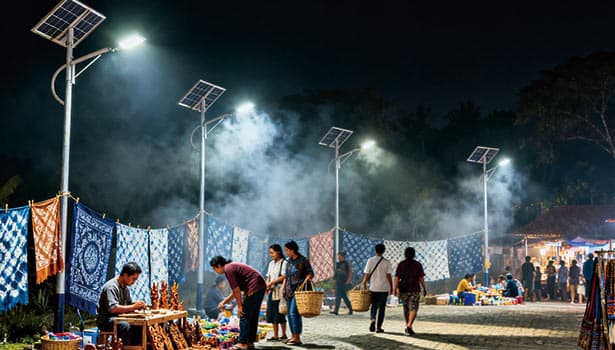
Optimize the Social Ecology
The extension of light not only illuminates the rural roads but also warms the villagers' lives, promoting the transformation of the rural social ecology from isolation and isolation to harmony and cohesion, significantly enhancing the villagers' quality of life and sense of happiness.
Strengthen security guarantees
Insufficient lighting is one of the main causes of rural safety accidents. In rural areas without streetlights, accidents such as pedestrians tripping over stones and electric bikes colliding with bicycles occur frequently at night. Meanwhile, the dim environment also provides opportunities for criminal activities such as theft and robbery. After the installation of solar led street lights, the brightness of public areas such as rural roads, squares and village committees has been increased to 30-50 lux, completely eliminating blind spots in lighting.
Enrich social life
The bright public space provides a stage for the development of rural social activities. After nightfall, the village square becomes the liveliest place. Villagers dance traditional dances, play folk Musical Instruments, play chess and chat under the village solar street lights, while children chase and play nearby. Many villages also rely on street lighting to hold cultural activities such as harvest festivals, religious blessings, and wedding markets, allowing traditional culture to be passed down in the lively atmosphere of the night.
Empower women's development
In traditional rural areas, the safety hazards at night greatly restrict women's range of activities. Many women dare not go out to work, shop or participate in social activities at night. The installation of solar outdoor street lights has cleared the obstacles for women's night activities and provided them with more development opportunities.
Upgrade Public Services
Medical care and education are core components of rural public services.Solar street lights, by improving the service environment and extending service hours, have transformed rural medical and educational services from weak foundations to convenient and accessible ones, accumulating momentum for the long-term development of rural areas.
Improve the accessibility of medical services
Rural health clinics are the "first line of defense" for villagers seeking medical treatment, but insufficient lighting once seriously restricted their service capacity. Many rural clinics, due to dim lighting, are unable to provide night consultations. Patients with acute and severe conditions have to take the risk of traveling to township hospitals dozens of kilometers away, thus missing the best treatment opportunity. Meanwhile, medical staff often encounter accidents when making night calls due to the pitch-dark roads.
After installing solar LED street lights, this problem was completely solved. The health clinic, with the aid of street lighting, has extended its consultation hours from 5 p.m. to 10 p.m., enabling it to promptly handle common conditions such as fever, diarrhea, and trauma. The rural roads illuminated by streetlights have also significantly enhanced the safety of medical staff's night clinics.
Help improve the quality of education
Education is the foundation of rural development, and the improvement of lighting conditions provides a direct boost to the enhancement of rural education. In many remote villages, due to family poverty or unstable power supply, many students are unable to study at home in the evening. Meanwhile, due to the lack of illuminated venues, adult education is difficult to be carried out effectively, resulting in a slow improvement in the quality of rural labor force.
After the installation of solar powered street lights, the playground of the village primary school and the activity room of the village committee were transformed into "night study points", equipped with desks, chairs and table lights. Students can go to the study points to do their homework and review their lessons in the evening. Village cadres will also invite teachers from rural schools to come for tutoring. In addition, "nighttime learning points" have also become important bases for adult education. The village has taken advantage of street lighting to hold agricultural technology training, small business operation courses, etc. The cultivation of high-quality labor force has injected strong potential into the sustainable development of the rural economy.
Improve the Infrastructure System
Infrastructure is the cornerstone of rural development. As a new type of infrastructure, village solar street lights not only make up for the shortcomings of rural lighting but also promote the development of rural infrastructure towards green, autonomous and complete directions, laying a foundation for the long-term progress of rural areas.
Realize energy autonomy
In many remote areas around the world, many rural areas have not yet been connected to the national power grid, or due to the aging of power grid lines, the power supply is unstable, which seriously restricts the development of rural areas. solar-powered village street lights do not rely on the power grid. They can achieve energy self-sufficiency solely through solar energy, providing a stable lighting solution for these villages.
Protect the ecological environment
Traditional streetlights rely on fossil energy sources such as thermal power for power supply, which generates a large amount of carbon emissions and pollutants. However, solar energy is a clean and renewable energy source. The use of solar led street lights in rural areas can effectively reduce the impact on the environment. It is estimated that a 100-watt solar LED street light can save 120 kilograms of standard coal and reduce 320 kilograms of carbon dioxide emissions and 9.6 kilograms of sulfur dioxide emissions each year.
In an eco-village in Costa Rica, 180 solar street lights have been installed, which can reduce carbon dioxide emissions by 57.6 tons annually, equivalent to planting 3,200 trees. Meanwhile, solar street lights do not require ground excavation to lay lines, avoiding damage to tropical rainforest vegetation. They are perfectly integrated with the ecological protection concept of rural areas and help develop the ecological tourism industry in rural areas.
Upgrade infrastructure
Lighting is an important part of rural infrastructure. The installation of solar outdoor street lights not only makes up for the shortcoming of lighting but also drives the upgrading of other rural infrastructure. Many villages have not only installed street lights but also hardened village roads, renovated public squares, and built supporting facilities such as bus shelters and garbage classification stations.
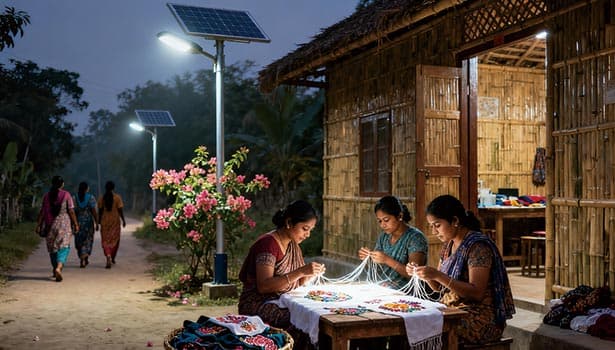
Let Solar Street Lights Illuminate More Villages
To promote the wide application of village solar street lights in rural areas and realize their value in facilitating rural progress, the following action suggestions are put forward for different entities:
Rural Managers: Implement Precise Policies and Ensure Implementation
Conduct demand research: Comprehensively investigate the lighting shortcomings of the village, focus on marking key areas such as roads, squares, health clinics, and schools, and formulate a streetlight installation plan based on the villagers' needs.
Seek external support: Actively connect with government rural development projects, international aid agencies or public welfare organizations, and apply for financial subsidies and technical guidance for the installation of solar street lights.
Pilot promotion first: Select densely populated areas with urgent needs as pilot areas to install solar street lights. Attract villagers' support through actual results, and then gradually expand the coverage.
Establish an operation and maintenance mechanism: Form an operation and maintenance team composed of village cadres and villagers' representatives to regularly clean and inspect the streetlights to ensure their long-term stable operation.
Industry Practitioners: Professional Services, Ensuring Efficiency
Precise selection and adaptation: Based on the geographical location, duration of sunlight, terrain conditions, etc. of the countryside, recommend solar street light products with suitable power, energy storage capacity, and wind resistance level for the countryside.
Provide professional installation: Form a professional installation team, formulate a reasonable installation plan based on the rural terrain, and ensure that the streetlights are firmly installed and the lighting effect meets the standards.
Improve after-sales service: Establish a 24-hour customer service hotline to provide services such as streetlight fault repair and parts replacement for rural areas. At the same time, regularly conduct technical training to enhance the professional capabilities of rural operation and maintenance personnel.
Innovative cooperation models: Introduce flexible cooperation models such as "leasing + operation and maintenance" and "trade-in" to reduce the initial investment pressure in rural areas and accelerate the popularization speed of solar powered street lights.
Every ray of light from solar-powered village street lights carries the hope of rural development. As more and more solar street lights are lit up in rural areas around the world, rural communities will steadily move forward on the path of economic development, social harmony, service upgrading and ecological improvement.

